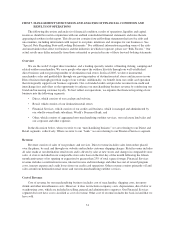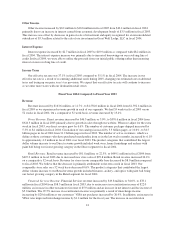Cabela's 2005 Annual Report Download - page 45
Download and view the complete annual report
Please find page 45 of the 2005 Cabela's annual report below. You can navigate through the pages in the report by either clicking on the pages listed below, or by using the keyword search tool below to find specific information within the annual report.Increased gasoline prices. Increased gasoline prices may affect us more negatively than our other retail
competition. We rely on destination retail store formats where some of our customers must drive hundreds of
miles to visit our stores. If gasoline prices increase, customers may opt to shop at competitors located closer to
large populations. Our new store locations in 2005, as well as future planned locations, are primarily located
closer to larger metropolitan areas, which we believe will help mitigate the impact of gasoline price increases on
our Retail sales.
Declining Comparable Store Sales. Our comparable store sales have declined for the last six quarters. We
believe there are multiple factors that have contributed to the decline. The first factor is increased gasoline prices
as discussed above. The second factor for fiscal 2005 was that the largest and most productive store in fiscal
2004, our Hamburg, Pennsylvania store, entered the comparable store base. The opening of that store was
extremely successful, which made comparisons difficult. However, despite not meeting its comparisons to the
prior year, our Hamburg store was still one of our most productive stores at over $420 per square foot in sales for
fiscal 2005. The third factor in declining comparable store sales was the location of our Dundee, Michigan store,
which we believe was impacted by economic conditions related to layoffs in that region. The fourth factor is a
cannibalization of our own Retail store sales in Owatonna, Minnesota, with the opening of our new store in
Rogers, Minnesota.
Competitors aggressively building new stores. Our competitors are actively building retail stores in our
markets. We seek to increase our merchandising revenue by continuing to make significant investments in new
destination retail stores, in initiatives to improve our website and enhance our customer database and in analysis
tools to improve our catalog marketing, which is the primary form of marketing for our merchandising business.
Catalog production and circulation costs. Prior to fiscal 2005, catalog production and circulation costs were
increasing more rapidly than Direct revenue. This had been caused by a variety of factors, including our strategy
to use our catalogs as an advertising and marketing tool for our entire business, including mailing additional
catalogs into markets where we have destination retail stores. In fiscal 2005, due to the growth in our Direct
business, Direct revenue growth outpaced the growth in our catalog costs. However, the costs of providing our
catalogs continue to increase as postage and printing prices increase. We estimate that the increase in postal rates
in 2006 will increase our catalog costs by 1.9%. We are mitigating those costs increases by entering into longer-
term contracts for paper and printing. In addition, we plan to develop and implement other strategies to reduce
order processing and distribution costs, and utilize our marketing database to determine optimal circulation
strategies.
Effect of retail expansion on direct business. When we open a destination retail store in a new market, our
Direct revenue in that market generally experiences a decline during the first twelve months of the new store
opening despite a substantial increase in our Retail revenue in that market due to the presence of our destination
retail store. The new retail store serves as a marketing tool in that geographic area. As a result, in the year
following the opening of the destination retail store, Direct revenue in that market has historically resumed its
historical growth rates. We were very pleased with the continued growth rate of our direct business in fiscal
2005, a year in which we increased our retail store square footage by 59.3%.
Investment in infrastructure. We anticipate that we will continue investing in our infrastructure to support
our new destination retail stores and in our management information systems department, which supports growth
in our website customer base. We expect that we will make investments in our data systems, and we expect to
hire additional employees in our shared services and corporate overhead areas in a manner appropriate to support
our revenue growth.
Saturation of our credit card. We anticipate that Financial Services revenue will increase as our portfolio of
managed loans matures, and we will seek to further increase Financial Services revenue by attracting new
cardholders through low cost targeted marketing and enhancing our loyalty program to encourage increased
customer usage of our credit cards. We will seek to control costs in our Financial Services segment by managing
33
























